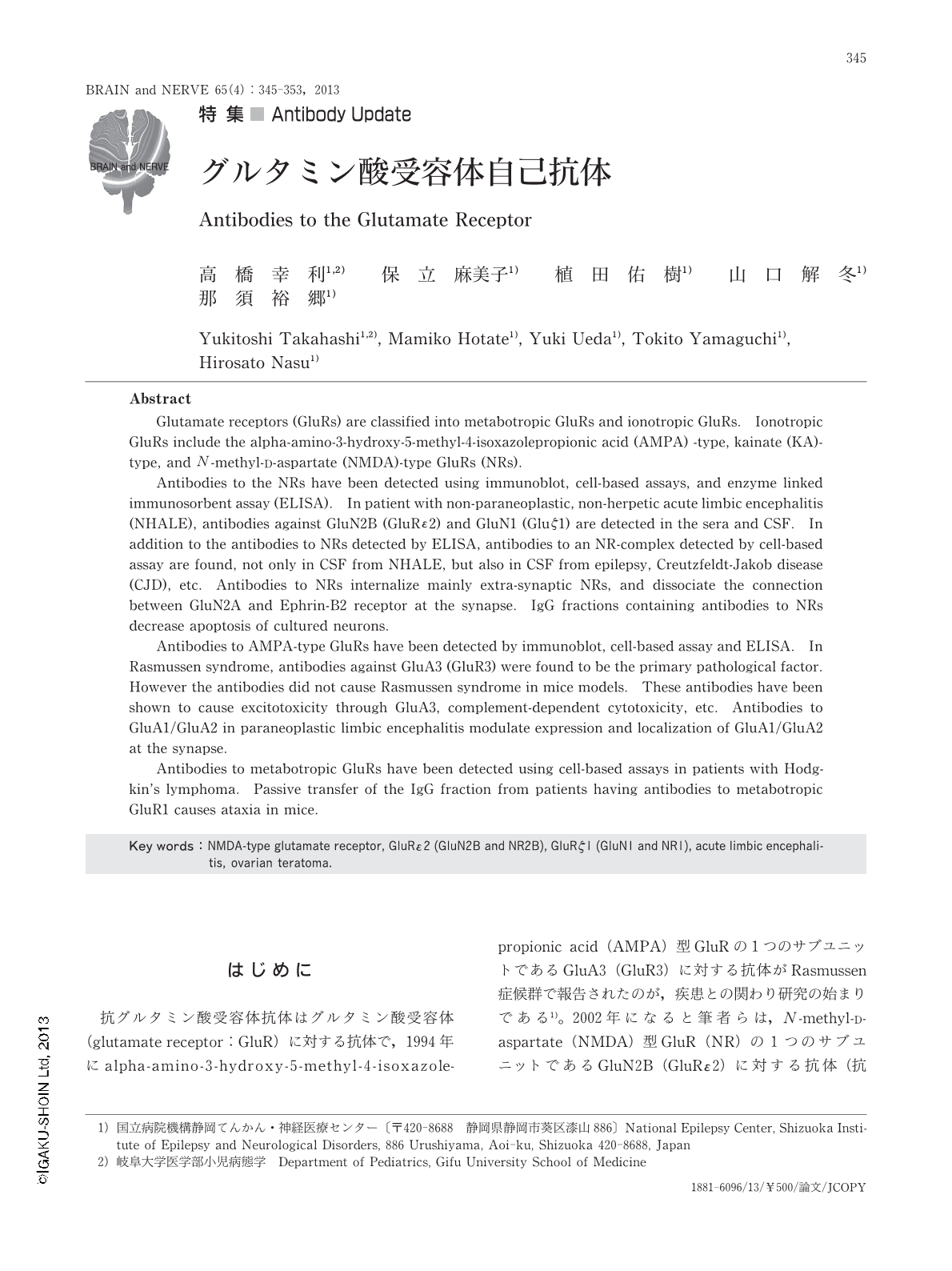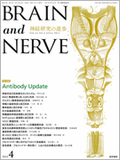Japanese
English
- 有料閲覧
- Abstract 文献概要
- 1ページ目 Look Inside
- 参考文献 Reference
はじめに
抗グルタミン酸受容体抗体はグルタミン酸受容体(glutamate receptor:GluR)に対する抗体で,1994年にalpha-amino-3-hydroxy-5-methyl-4-isoxazolepropionic acid(AMPA)型GluRの1つのサブユニットであるGluA3(GluR3)に対する抗体がRasmussen症候群で報告されたのが,疾患との関わり研究の始まりである1)。2002年になると筆者らは,N-methyl-D-aspartate(NMDA)型GluR(NR)の1つのサブユニットであるGluN2B(GluRε2)に対する抗体(抗GluRε2抗体)の存在を,非ヘルペス性急性辺縁系脳炎(non-herpetic acute limbic encephalitis:NHALE)を含む脳炎症例で報告し2),2003年には抗GluRε2抗体のRasmussen症候群でのデータを報告した3)。
2007年になると,Dalmauら4)はNMDA型GluR複合体抗体の卵巣奇形腫を伴う急性辺縁系脳炎(NHALE-OT)における報告を行い,NMDA型GluRの脳炎における意義が注目されるところとなった。2009年には抗GluA1/GluA2抗体が傍腫瘍性辺縁系脳炎で報告され5),抗GluR抗体の疾患との関わりが広がってきている。
現在では8種類以上の自己抗体介在性の脳炎(脳症)が知られているが(Table1),英国での前方視的疫学調査によると,脳炎の原因は単純ヘルペス脳炎(19%)>急性散在性脳脊髄炎(acute disseminated encephalomyelitis:ADEM)(11%)>抗NMDA型GluR抗体脳炎(4%)>水痘-帯状疱疹ウイルス脳炎(4%)>抗VGKC抗体脳炎(3%)の順で,自己抗体の関係する脳炎では抗NMDA型GluR抗体によるものが多いとされる6)。本稿では抗GluR抗体の中の抗NMDA型GluR抗体についての知見を中心に述べる。
Abstract
Glutamate receptors (GluRs) are classified into metabotropic GluRs and ionotropic GluRs. Ionotropic GluRs include the alpha-amino-3-hydroxy-5-methyl-4-isoxazolepropionic acid (AMPA) -type, kainate (KA)-type, and N-methyl-D-aspartate (NMDA)-type GluRs (NRs).
Antibodies to the NRs have been detected using immunoblot, cell-based assays, and enzyme linked immunosorbent assay (ELISA). In patient with non-paraneoplastic, non-herpetic acute limbic encephalitis (NHALE), antibodies against GluN2B (GluRε2) and GluN1 (Gluζ1) are detected in the sera and CSF. In addition to the antibodies to NRs detected by ELISA, antibodies to an NR-complex detected by cell-based assay are found, not only in CSF from NHALE, but also in CSF from epilepsy, Creutzfeldt-Jakob disease (CJD), etc. Antibodies to NRs internalize mainly extra-synaptic NRs, and dissociate the connection between GluN2A and Ephrin-B2 receptor at the synapse. IgG fractions containing antibodies to NRs decrease apoptosis of cultured neurons.
Antibodies to AMPA-type GluRs have been detected by immunoblot, cell-based assay and ELISA. In Rasmussen syndrome, antibodies against GluA3 (GluR3) were found to be the primary pathological factor. However the antibodies did not cause Rasmussen syndrome in mice models. These antibodies have been shown to cause excitotoxicity through GluA3, complement-dependent cytotoxicity, etc. Antibodies to GluA1/GluA2 in paraneoplastic limbic encephalitis modulate expression and localization of GluA1/GluA2 at the synapse.
Antibodies to metabotropic GluRs have been detected using cell-based assays in patients with Hodgkin's lymphoma. Passive transfer of the IgG fraction from patients having antibodies to metabotropic GluR1 causes ataxia in mice.

Copyright © 2013, Igaku-Shoin Ltd. All rights reserved.


